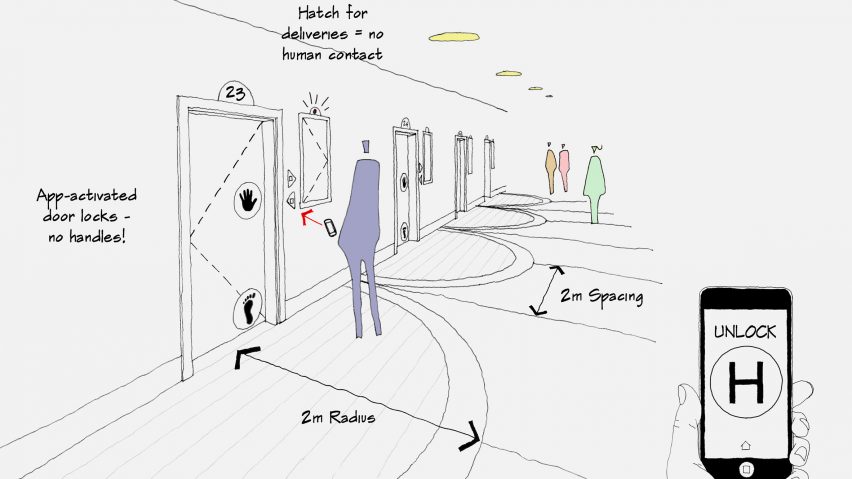UK architecture studio The Manser Practice has outlined how hotels could be adapted to allow social distancing when they reopen, and how future designs will be impacted by the coronavirus pandemic.
Post-pandemic hotels will have no receptionists and will adopt touchless access, one-way systems and larger rooms with inbuilt gyms according to The Manser Practice, which has designed numerous hotels including several for Hilton.
The coronavirus could also lead to a rejection of Airbnb, the death of hotel conferencing, the return to favour of the paternoster lift and the construction of custom-built, self-contained isolation hotel rooms.
"People will want the assurance of clean space"
The studio predicts that a key focus of future hotel rooms will be cleanliness and the reduction of unnecessary contact – something that is hard to achieve in shared spaces with a quick turnover of guests.
This could lead people to move away from private rental services like Airbnb in favour of larger hotel chains.
"People will want the assurance of properly maintained, clean space," said Jonathan Manser, CEO of The Manser Practice.
"Could we see the demise of the Airbnb model as consumers move towards assured cleanliness?" he asked Dezeen.
"There's no guarantee, when renting from another consumer, that interiors have been properly cleaned since the last use – this gives an advantage to the hotel industry and particularly, one suspects, to the big international brands."
In the short term, hotels will be adapted to minimise the interaction between staff and guests, with receptionists replaced by touchless check-in with temperature checks, while doors will be opened using a smartphone.
"Do visitors still need to be welcomed and checked-in by receptionists?" asked Manser. "A hotel app could instead give guests touchless access to their room, delivery hatch and other hotel amenities."
"Using smart technologies to minimise the number of touch points between entry and the hotel room will put guests more at ease about potentially contaminated surfaces." he continued.
"We imagine a return to the old forms of room service"
To reduce the contact between guests in existing hotels, which often have numerous rooms serviced by a single corridor, Manser suggests implementing one-way systems.
"As a whole, the internal spatial layout of hotel buildings might change to one-way systems to minimise the crossover points of guests in narrow corridors," said Manser.
To reduce the need to visit restaurants and for other staff to enter rooms, Manser believes that hotels could add "remote room delivery" services.
"We imagine a return to the old forms of room service," he explained. "A remotely activated hatch on to the corridor giving access to a space big enough for delivery meals, laundry and dry cleaning etc."
"Staff place items in from outside and guests retrieve them from inside via a similar hatch," he continued. "Dirties take the reverse route. Staff won't need to enter the room, improving both privacy and social distancing."
On a longer time scale, Manser believes that the coronavirus will impact how space is allocated in hotels, with greater priority placed on spacious rooms and a reduction in facilities like conference rooms and gyms.
"Guest rooms might get bigger to allow more space for in-room work rather than people risking using the shared spaces with other guests," explained the architect.
"Similarly, gyms full of sweaty fellow guests might now not seem as attractive as an in-room exercise space," he continued. "Rooms could be extended with oriel windows containing bikes, yoga spaces etc. allowing exercise with panoramic views and 'activating' what are often bland hotel elevations."
"Lifts present the biggest challenge"
Another major structural change could be the reintroduction of the paternoster – a type of lift that was popular in the first half of the 20th century, which consists of a continuous chain of open compartments for one or two people rather than an enclosed lift for multiple people.
"Lifts present the biggest challenge – sharing a confined space with strangers, even with masks, will be off-putting," said Manser.
"More lifts and escalators might help, but we see a potential for the good old paternoster lift to be modernised, which could not only move people around more efficiently but, in some hotels, add to the theatricality of the central space."
Manser also sees a potential need to build "quarantine hotels" that could be used by those stuck in foreign countries. The studio has designed a self-contained room (shown above) that would contain many of its predictions for the post-pandemic hotel.
"And finally, looking further ahead, the prediction is for more pandemics as travel increases, as well as country-specific (or second wave) Covid outbreaks," explained Manser.
"There will be increased demand for 'quarantine hotels', not only for guests to get away but for those 'stuck' in other countries unable to travel home," he continued.
"We've roughed out plans for a 28 metre-squared Utility Pod, with bed, bath, wardrobe, minibar, delivery hatch workspace and gym all in the one space – a self-contained isolation hotel room!" he added. "Robot cleaning might be an option as well but we haven’t yet cracked automatic bed making!"
Other architects and designers are also predicting how the urban environment will be impacted by the pandemic. Weston Williamson + Partners outlined its plans for a social-distancing workplace, while Curl la Tourelle Head has proposed tent classrooms for socially distanced learning.

